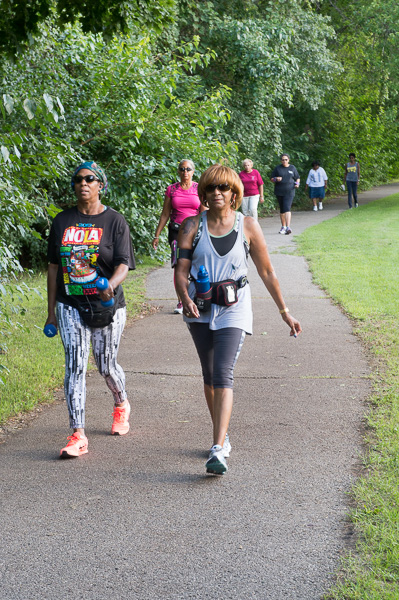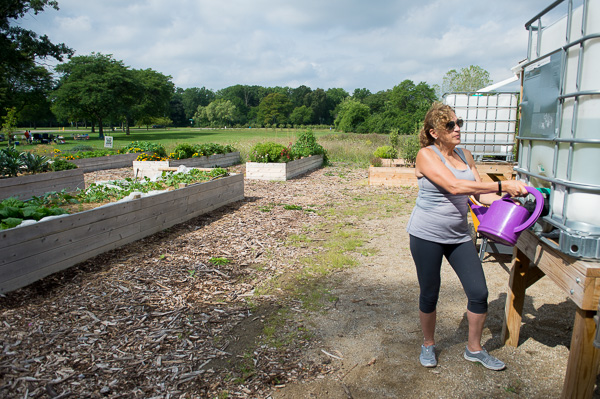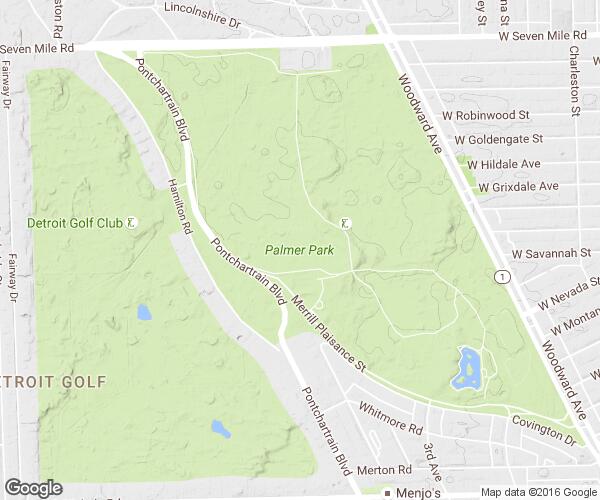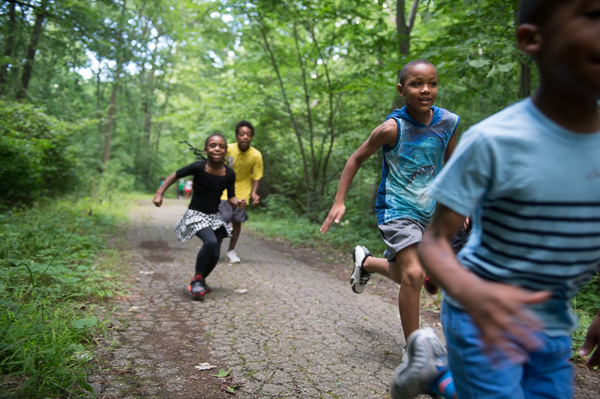The People's Park: How grassroots organizers have reinvigorated Palmer Park
Brian Allnutt |
Wednesday, September 07, 2016
It's safe to say that the women of the Palmer Park walking group Step to Greater Health, most of whom are twenty or thirty years older than me, are in better shape than I am. The night I met them, there was a healthy turnout despite the 90-degree weather and quick pace set by the group—three miles in roughly 45 minutes.
One woman named Joyce kept slowing down to stretch and do calisthenics. But every time I came close to catching up with her, she'd take off. The aerobics cool down that followed the walk didn't go much better.
 Members of walking group Step To Greater Health
"Flow with it more Brian," I was instructed as the ladies around me made graceful movements from side to side. I seemed to be almost perfectly out of synch, flowing in one direction as they flowed in the other.
These women were clearly enjoying themselves and they weren't the only ones. Scores of people were using the park on the hot summer night. There were cheerleaders, football players, tennis players, older men in camping chairs, and more.
But if the park was succeeding as a destination, it was still falling short as a facility. Grape vines and mulberry bushes overwhelmed the path as it ran along the golf course. There's essentially no path from Woodward to the center of the park along Merrill Plaisance, forcing us to walk in the street.
Still, the walking club speaks to the sense of energy and community that has emerged at Palmer Park recently, thanks in large part to the nonprofit People for Palmer Park
Members of walking group Step To Greater Health
"Flow with it more Brian," I was instructed as the ladies around me made graceful movements from side to side. I seemed to be almost perfectly out of synch, flowing in one direction as they flowed in the other.
These women were clearly enjoying themselves and they weren't the only ones. Scores of people were using the park on the hot summer night. There were cheerleaders, football players, tennis players, older men in camping chairs, and more.
But if the park was succeeding as a destination, it was still falling short as a facility. Grape vines and mulberry bushes overwhelmed the path as it ran along the golf course. There's essentially no path from Woodward to the center of the park along Merrill Plaisance, forcing us to walk in the street.
Still, the walking club speaks to the sense of energy and community that has emerged at Palmer Park recently, thanks in large part to the nonprofit People for Palmer Park, who have officially adopted the park and manage it in conjunction with the City of Detroit. Latricia Wright, the organizer of the walking club, mentioned their garbage cleanup and path clearing in the woods several years ago as a turnaround moment. Several of the women told me they had only come back to the park or started coming to it as a result of the walking group.
Wright became interested in Palmer Park after living in Las Vegas for several years where she enjoyed easy access to walking and hiking destinations. This was something I heard from other people in positions of leadership in the park: spending time in other cities made them think about what they wanted to see in Detroit.
Nearly everyone I talked with said the park was safer than it had been before, a perception that's kind of a self-fulfilling prophecy. "Safety goes hand in hand with more people," says Rochelle Lento, president of People for Palmer Park. "The more people that are in the park, the safer that people feel in the park."
It's not hard to see a contrast here with one of Detroit's other major parks, Belle Isle. Where discussions of Belle Isle often revolve around major players like The Department of Natural Resources, Roger Penske, The City Council and, in at least one instance, Metallica, the conversation around Palmer Park concerns the grass-roots organizations and a number of low-profile actors. Dan Scarsella of Motor City Brewing Works donated and maintains an apple orchard in the park; Lindsay Page runs the community garden; the LGBTQ people of color organize the Hotter than July festival, and so on.
 People for Palmer Park president Rochelle Lento fills a watering can at the park's community garden
People for Palmer Park president Rochelle Lento fills a watering can at the park's community garden
Both structurally and in terms of the overall vibe, Palmer Park has the feel of a people's park as opposed to what's sometimes called the "the island gem," suggesting both beauty and inaccessibility. As Clinton Griffin, the vice president for the People for Palmer Park, says, "This has become the replacement for Belle Isle for whatever reason."
The layout of the park itself encourages a porous relationship with its surroundings. "The park is also in a neighborhood," Lento says. "It's in the Palmer Park Apartment District neighborhood. So that's in and of itself unusual. There's not even that much of a physical, geographic distinction between that apartment district and the park."
(Check out this Model D article for more information on neighborhood revival efforts)
Where Belle Isle is an island unto itself with an easily controlled entrance and exit, and other parks in Detroit—like Chandler Park and Balduck Park—have hard rectilinear edges, Palmer has a more amorphous shape. Landscape ecologist Richard Forman has said that the ideal park is "spaceship shaped" with "a rounded core for protection of resources, plus some curvilinear boundaries and a few fingers for species dispersal."

Of course, in the urban park, one of the most important species to be dispersed and attracted is human.
Although Palmer Park is far from being Full Spaceship—it has hard edges along Woodward and Seven Mile—it has soft curvilinear borders on the south and east, as well as a small projection of land moving north of Seven Mile into the Palmer Woods Neighborhood. This shape facilitates multiple entryways from diverse neighborhoods and encourages a casual engagement that helps incorporate the space into daily life.
Griffin told me that he began to pay attention to the park almost accidentally when he moved across the street to take care of a family member. As he saw volunteer groups working on different parts of the park, he became interested in its potential. "It's intersected at all these different socioeconomic things," he says. "It's a place where all of these people can come and enjoy themselves."
The recent master plan organized by the Gibbs Planning Group, with input from a number of actors, emphasizes entryways to the park, improved street crossings on Woodward, a circular drive coming south from Seven Mile, tree-covered pedestrian walkways running along Woodward Avenue to improve the experience of people walking along the park, and a promenade on the southeast corner that will be joined by paths leading into the park's center.
Other important parts of the plan include restoring elements of Frederick Law Olmsted's original design, such as the meadow and lake along Picnic Way and a large farm in the park's center.
This last item, along with the apple orchard, are a pieces of programming that mix well with the pastoral elements of park scenery and continue the mission of the park's founder, former U.S. Senator Thomas Palmer, who carried out various experiments in scientific agriculture in the park and produced cider from his orchard on the farm. The nutritional aspect of these projects also furthers the work of Palmer's wife, Lizzie Merrill Palmer, who founded the Merrill Palmer Institute for Motherhood and Home Training that later became part of the Merrill Palmer Skillman Institute at Wayne State.
 Members of the Marathon Kids take part in a group run through Palmer Park
Members of the Marathon Kids take part in a group run through Palmer Park
Public and private partnerships have become important for the sustainability of a number of parks, most prominently Central Park in New York City where the Central Park Conservancy has led a decades-long turnaround.
That's no different here, where The People for Palmer Park have sparked the conversation. They've accomplished this to a large degree by attracting people to the park through programming and events, like Log Cabin Day and The Palmer Park Art Fair, as well as tai chi classes, yoga, bike rides, the community garden, youth sports, the walking club, and more.
With so much focus on the highly-successful social aspects of the park, it might be easy to lose sight of another important function that parks serve: providing urban residents with solitude and a connection to nature or some semblance thereof. For this it will be important to get the woods—which Tom Palmer demanded be left undisturbed—into a condition that is open and inviting. This area is a remnant of the vast forests that used to occupy the area and forms a vital link to our ecological heritage.
The People for Palmer Park will be using a grant from the Kresge Foundation to investigate ways to drain the woods and filter the water through Lake Francis on the south side of the park, a change that could decrease the level of mosquitoes in the woods and make the area more approachable. Like the agricultural work being done in the park, it also forms a link to Detroit's history and a legacy of stewardship that was championed by the Palmers.
Palmer Park is in the midst of a revival, and all signs suggest that's likely to continue. Which is a real testament to the power of grassroots organizing.
All photos by Sean Work.